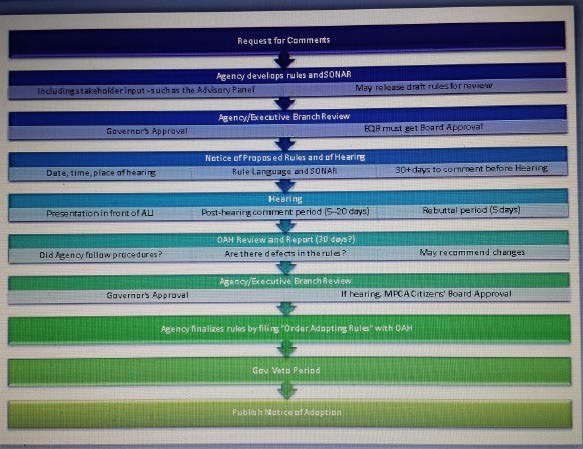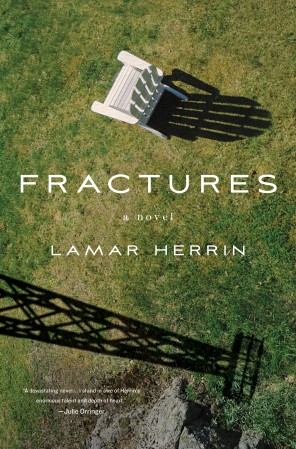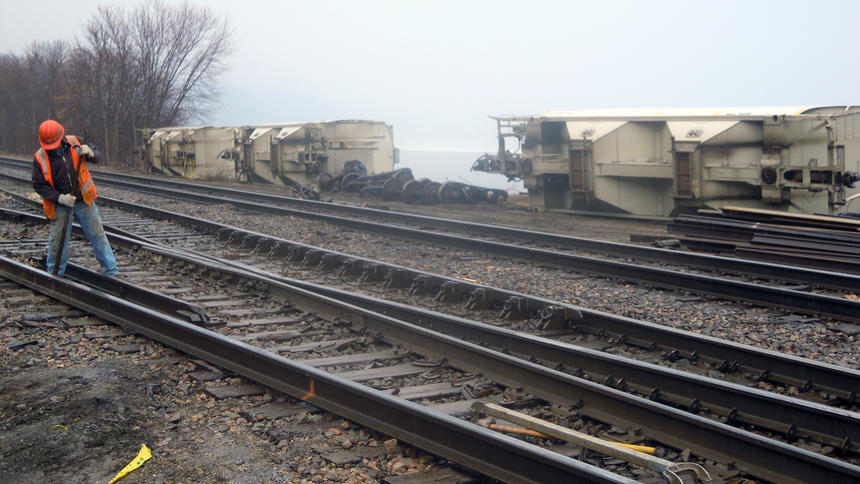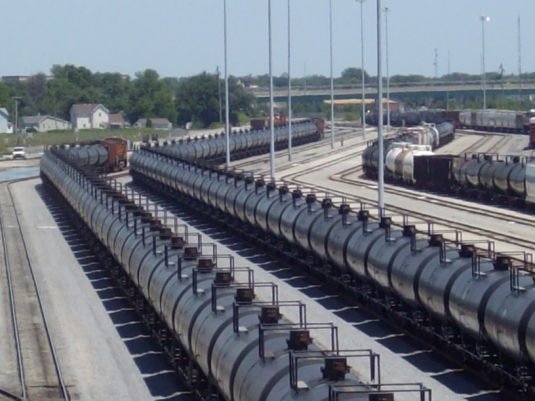Bogus Silica Sand Rulemaking Advisory Panel
June 22nd, 2014
To the rulemaking staff at MPCA, EQB and DNR: YOU’RE AVOIDING PUBLIC INPUT ON DRAFT RULES PRIOR TO BRINGING TO PROPOSAL TO THE BOARD. NOT ACCEPTABLE!
DISCLOSE DRAFT RULES FOR REVIEW BY ADVISORY COMMITTEE PRIOR TO TAKING TO EQB BOARD!
“Bogus?” Yes, bogus, because a Rulemaking Advisory Committee is “to comment, before publication of a notice of intent to adopt or a notice of hearing, on the subject matter of a possible rulemaking under active consideration within the agency.” That is NOT happening.
What is there to show for the YEAR since the statute was passed and signed to trigger this rulemaking? What is there to show for the SIX MONTHS of monthly meetings of the Rulemaking Advisory Committee? Here it is — the agencies’ “DRAFT concepts” document that they passed out at the May 18 meeting (note it’s not even close to a DRAFT rule):
I was told that it would be posted on the Advisory Committee page, well, that was over a month ago and it’s still not posted in preparation for or after the June meeting. Looking at that Advisory Committee page, there are no materials published for the May meeting, nor are there any for June:
This is not public involvement, and this is not providing an opportunity for review of the draft rules. This committee has been meeting for six months now, and there’s a statement that the proposal will go before the EQB in September…
So back to the EQB. Thursday’s EQB meeting was a long meeting, one which Alan and I only attended for the CO2 discussion and did not stay for the silica sand discussion (we both received only one day’s notice on this pre-meeting “listening session.”). No packet materials were posted. From the EQB site: EQB board meeting proposed agenda, June 18, 2014: Agenda and accompanying materials for meeting, June 18, 2014. (54.38K, .pdf). NOTHING in the way of materials whatsoever, though one member commented on the large quantity of materials in the packet.
Now I’ve had a chance to listen to the video (THESE VIDEOS ARE MUCH APPRECIATED!). Check it out:
During the silica sand part, EQB E.D. Will Seuffert stated that the Advisory Panel met yesterday, that would have been June 17, 2014, and that their intent is to have a proposal before the Board for the September meeting.
So the Rulemaking Advisory Committee will see the proposals when and have time to review them when??? This committee has been meeting for six months and has yet to have a draft rule to review.
Since day one, I’ve been warning, predicting, declaring, that what these agencies are doing is paying lip service to engagement of the public, the “stakeholders” in this process, and forging on without giving them any opportunity to participate in a meaningful way, and certainly not giving them any opportunity to comment on rule drafts as anticipated by the statute. I’ve been pushing staff about it, and get assurances that no, that’s not what’s going on. HA!
Check this video, particularly starting ~ 53, where DNR staff is explaining rulemaking at the FIFTH meeting of this Rulemaking Advisory Committee, talking around participation of the committee and brushing off any expectation of a draft rule. GRRRRRRR. LISTEN TO MAY MEETING HERE.
And to add to the mess, those supposedly representing the public are not providing updates to those they’re supposed to be representing. GRRRRRRRRRRR. No reports on these meetings whatsoever. As representatives, it’s your job to provide updates after the meetings with analysis of what happened and next steps. Nada… not a word. I’m certainly not feeling represented!
Some posts on the failure of agencies involved to properly and meaningfully utilize the Advisory Committee to comment on DRAFT RULES:
Silica Sand Rulemaking off track… April 30th, 2014
Someone explain rulemaking to the MPCA March 2nd, 2014
And once more with feeling, state law clearly and expressly authorizes and establishes the role of a Rulemaking Advisory Committee. The statutory purpose is to COMMENT on the proposed draft… BEFORE it’s published:
These agencies adamantly objected to formation of an Advisory Committee, from that earlier blog post, “Someone explain rulemaking to the MPCA“ here’s the MPCA resistence and an explanation:
MPCA staff’s report to the EQB stated inexplicably that they were “confused,” claiming ignorance of how rulemaking works and the impact of comments at this stage:
i. Staff requests Board direction on a question that arose at the August 2nd public meetings.
Who cares about rulemaking? Who cares about rules? I care! Anyone looking to the state to protect the health and safety of Minnesotans! And that IS their job.
FYI, an aside… recently a little birdie involved with a new sand plant in Wisconsin told me that it’s not in compliance with air permits, and might not ever be able to bring it into compliance (not without spending more money on limiting emissions than they want to!). These emissions rules being developed in Minnesota are crucial.
Rules are important. Let’s see the DRAFT rules and give us reasonable time to review and comment!
A fracking good novel for an “on deck” read!
May 5th, 2014
A novel about fracking…
Fractures, by Lamar Herrin
It’s a beautiful day today, just had a meeting all afternoon in the park in Zumbrota, and it’s a perfect day to sit on the deck in the SUN (what a concept!) and read!
For those of us “in the middle” dealing with frac sand mining and the Bakken BOOM trains, this book is a must read, dealing with the big picture and the more mundane, how one family copes and doesn’t cope when fracking comes to their community and their land. This book is a welcome sidebar to our day to day activism.
It’s at the Red Wing library, in the SELCO system, and you can find it at abebooks.com.
Speaking of trains… BOOM!
April 30th, 2014
Photo provided by the City of Lynchburg, Virginia April 30, 2014.
+++++++++++++++++++++++++
Platts confirms it was Bakken BOOM! crude oil:
CSX says 15 cars derailed from train in Virginia
The Bad Oil Boom: Crude Train Explodes in Lynchburg, Virginia, While Regulators Chug Along
This time it’s Lynchburg, Virginia. Don’t know where the train originated, what type of oil, but there is indeed a trend!
Video from News8000.com
Bakken BOOM crude oil MUST be DEGASIFIED before it is shipped, shipped by rail, shipped by pipeline, it must be DEGASIFIED before it goes anywhere, because the high gas content is what makes it dangerous. DEGASIFY now. How many more towns must burn before they DEGASIFY?
Here’s the DOT letter regarding degasifying:
And here’s the part that addresses degasifying the crude before transport:
Come on, DOT, how hard is that to understand? Bakken crude must be degasified before it goes rolling down the track.
From Common Dreams:
From Reuters:
From desmogblog:
Breaking: CSX Railroad “Bomb Train” Carrying Crude Oil Explodes in Lynchburg, Virginia
From the STrib:
Tanker cars carrying crude oil derail, catch fire in Lynchburg, Va.; buildings evacuated
Silica Sand Rulemaking off track…
April 30th, 2014
Well, that’s not quite right. This “rulemaking” has yet to get ON track, and that’s what’s bothering me.
Remember when the MPCA staff said they couldn’t imagine how a rulemaking advisory committee could or would work? From an earlier blog post, “Someone explain rulemaking to the MPCA“ here’s the MPCA resistence and an explanation:
MPCA staff’s report to the EQB stated inexplicably that they were “confused,” claiming ignorance of how rulemakign works and the impact of comments at this stage:
i. Staff requests Board direction on a question that arose at the August 2nd public meetings.
Once more with feeling, state law clearly and expressly authorizes and establishes the role of a Rulemaking Advisory Committee. The statutory purpose is to COMMENT on the proposed draft… BEFORE it’s published:
Once more with feeling… you’ve got to have a DRAFT to COMMENT ON!
Here’s the link for the state’s Silica Sand Rulemaking Advisory Panel page. And from that page:
Past meetings
April 2014
March 2014
- Meeting notes (March 2014)
- See the recorded WebEx
- Presentation: Air permitting 101 – Air regulations and permits
January 2014
The panel first met on January 29.
Look at this presentation, beginning at 10:40, where there’s an “explanation” with a slide for the group:
Catherine Neuschler’s explanation, at the April meeting (rough version, not quite exact) which goes around the PURPOSE of an Advisory Committee, which is to review drafts:
Your role is to inform the agencies on their silica sand rulemakings … on proposals or other key issues, things we bring to you and you want to bring to us… There’s not going to be… we do not expect any preparation for a panel report, meeting notes and recordings, provide record of what was said, not expecting a panel report. Of course all of you can make official comments as part of the rulemaking process… (no mention of draft review!!!), if you want to work together as a group to write some comments, or as a subgroup, to write some comments… To bring home what those places are where you may have the opportunity, where you will have the opportunity to weigh in (referring to chart above). Here’s a simplified version of the rulemaking process as a reminder, the process we’re in now is”Agency develops rules and SONAR” so that’s where we’re looking for stakeholder input … Various agencies, depending on how they do their process, may release drafts rules for public review, certainly if we do that, if any of the agencies do that, that will be a place you can weigh in. The next step is Agency and Executive Branch review…
WOW! Then a discussion of how this process goes forward:
The way I view then, the next step, what we’re doing internally in the PCA, is that in the summer, we’ll present, the agencies will present some conceptual overviews of rule concepts, and I am adamant, that’s going to look a lot like this, that it’s going to say something like, what’s there, what do we think we want to do, if it’s Air Emissions, OK, we think Best Management Practices, monitoring, something else, what do we think those will consist of, and present that to you for your feedback, so that you really have a sense of what do we think is important, where do we see this rule going, and can respond to that and give us that feedback. Charlie and I were talking about this a little bit in the car, sort of to give you that concept before we get into that, what do all the little details of the words have to say, because then I think you can understand where we think we’re going, give us some feedback on that, and then when we start to write the language, if it doesn’t operationalize the concepts that we talked about, you can say, that is not what you said you were going to do, we read this as something completely different.
The way I view this going foward, in the summer, we’ll present some of those conceptual overviews, various agencies will do that, then at the end of the summer, Will and I have been talking about it, we’ll use an EQB meeting, as sort of a public review of those conceptual overviews from all of the agencies and the where the public can have more input as well, and then in the fall, if the agencies would make presentations with some more defined rule proposals, and how defined they is going to vary by agencies, but probably some real concrete rule language and SONAR.
So that’s how we view it moving forward, and if something is a really big concern to you guys, obviously we can adjust. Your advice and your input is very, very valuable to us… It’s advice and input… We don’t expect a written product, we don’t expect that this is a voting process. We’ll be listening for consensus, for what we hear… that you’re all on the same page and you agree, that some people are kind of reserved about it it but you can live with it… we’re not going to be doing voting…. Our goal is that the rules that result from this process is that we’ll have rules everyone can live with. That’s really what we’ve found with this stakeholder process.
So what I’m getting out of this is that this summer, “concepts” will be brought to the committee for feedback, and that maybe, MAYBE, they might get some draft rules before the agencies present it with the SONAR for comment. Most I’ve heard is that they “hope” to have some draft language. The law was passed what, last May? These meetings started in January, and September is 9 months from January. It shouldn’t take that long. Bottom line, I think this is a “make work” thing for avoiding producing the draft rules for review.
From the MPCA site:
Upcoming meetings
CARS – Last night in La Crosse
April 23rd, 2014
Citizens Acting for Rail Safety (CARS) held a meeting last night in La Crosse, WI, to discuss the proposal to build a second rail line in the middle of La Crosse. It was packed, over 300 people, standing room only. The comments of those attending shows the level of concern over The rail company, BNSF, claims a second line is necessary due to increased traffic. We’ve seen the increase, I’ve experienced it here in Red Wing, watching the trains rumble through the heart of town. Well, folks, it’s time for us to rumble!
Residents express concerns over new rail line
Rail expansion prompts worries about dangerous cargo, unsafe rail cars
STrib article about the unsafe rail cars:
Failure rates raising new fears over use of aging oil tankers
And more on the La Crosse proposal:



